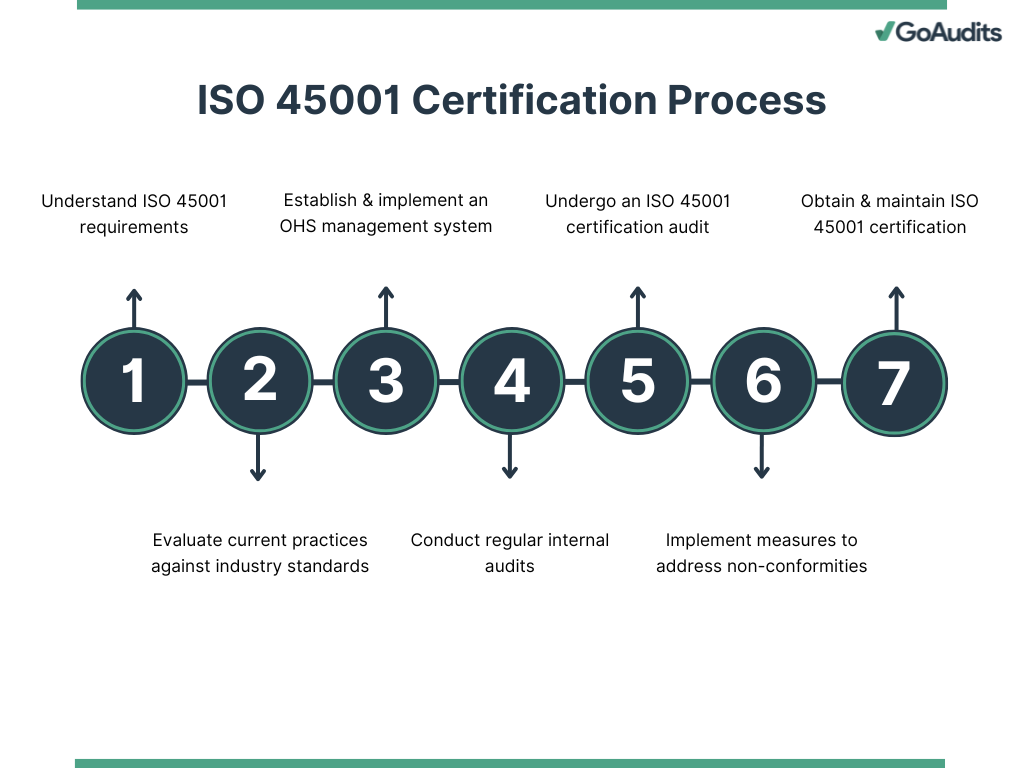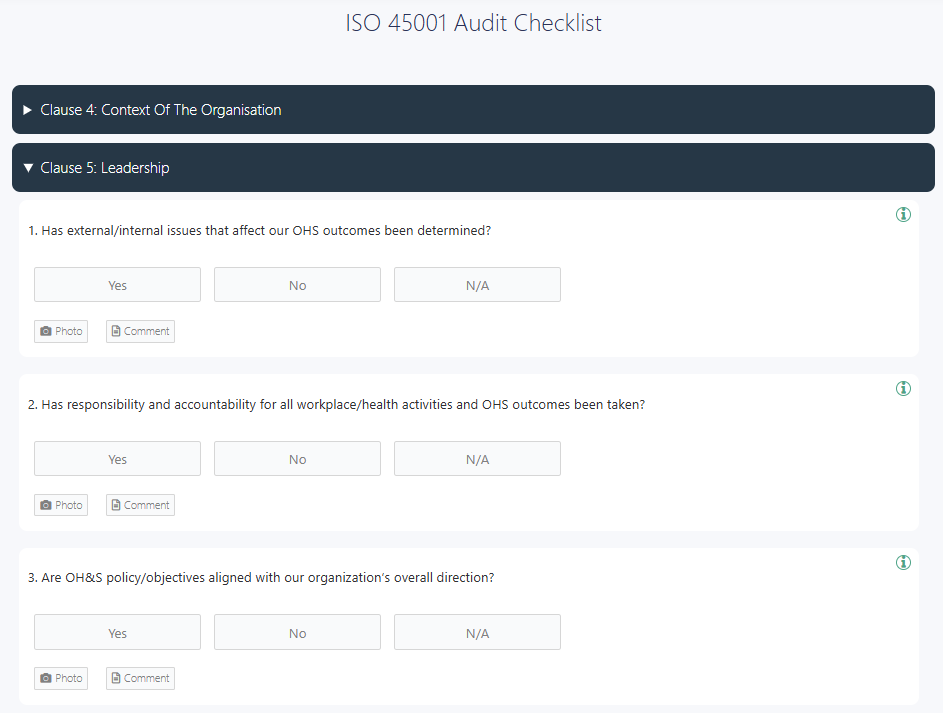ISO 45001:2018 is a globally recognized standard that outlines the requirements for Occupational Health and Safety Management Systems (OHSMS). Though ISO 45001 is applicable to any organization looking to implement an OHSMS, regardless of size, industry, or geographic location, it’s particularly more valuable for high-risk industries like construction, manufacturing, mining, oil and gas, etc. To obtain the ISO 45001 certification, organizations must undergo internal and external audits.
This article will explore the types of ISO 45001 audits, their importance, the certification process, and more.
- Understanding ISO 45001 Audits
- Types of ISO 45001 Audits
- Key Aspects Assessed During ISO 45001 Audits
- Steps Involved in ISO 45001 Internal Audits
- ISO 45001 Certification Process
- Streamline ISO 45001 Internal Audits with GoAudits
- Free Additional Health & Safety Audit Checklists
- Why are ISO 45001 Audits Important for Workplace Safety?
- What is ISO 45001 Software?
- How to Choose the Right ISO 45001 Software?
Understanding ISO 45001 Audits
ISO 45001:2018 is the latest version of the ISO standard, which replaced the previous standard OHSAS 18001. Organizations certified under OHSAS 18001 were granted a three-year period to migrate to ISO 45001, with the transition deadline set for March 2021. ISO 45001 uses the Plan-Do-Check-Act (PDCA) methodology, adopting a systematic approach to managing occupational health and safety risks, and can be integrated with other ISO standards.
ISO 45001 audits are formal, systematic examinations of an organization’s occupational health and safety management system to verify compliance with the ISO 45001 standard. These audits evaluate whether the organization’s health and safety practices are effectively implemented, maintained, and continually improved.
Types of ISO 45001 Audits
ISO 45001 audits are primarily categorized into internal and external audits, each serving distinct purposes in the certification process.
ISO 45001 Internal Audits
Internal audits are conducted by the organization’s trained staff to verify compliance and identify improvements before external assessments. Often called “first-party audits,” they’re performed by individuals independent of the audited processes to maintain objectivity. The primary goals of ISO 45001 internal audits include:
- Confirming compliance with ISO requirements and organizational policies
- Assessing the effectiveness of safety controls
- Finding opportunities to enhance safety performance
- Preparing for external certification audits
ISO 45001 Supplier Audits
Also known as ‘second-party audits’, these occur when one organization evaluates a contractor or supplier’s safety management system against ISO 45001 requirements. They help companies verify that their supply chain partners maintain appropriate safety standards, reducing operational risks and ensuring consistent safety performance across the value chain.
The process typically examines safety documentation, workplace conditions, and training programs to confirm adequate control of occupational health and safety risks. These audits can be conducted either by the organization’s own qualified staff or by hired external auditors acting on behalf of the organization.
ISO 45001 External & Certification Audits
External audits, also known as ‘third-party audits’, are performed by independent third-party auditors or certification bodies, who evaluate your organization’s compliance with ISO 45001 requirements. These audits provide an objective assessment of your OHSMS, identifying non-conformities and areas needing improvement. They are crucial for validating the effectiveness of your health and safety practices and demonstrating compliance to stakeholders.
Certification audits are conducted by accredited certification bodies to determine if your organization meets ISO 45001 requirements and ultimately delivers the official ISO 45001 certification.
This process involves a comprehensive evaluation of your OHSMS and is typically carried out in two stages:
- Stage 1: A preliminary assessment of your organization’s readiness for the certification audit, including a review of documentation and planning.
- Stage 2: A thorough evaluation of the implementation and effectiveness of your OHSMS, leading to the decision on certification.
Achieving ISO 45001 certification through this audit enhances your organization’s credibility globally.
Key Aspects Assessed During ISO 45001 Audits
During ISO 45001 audits, several critical aspects are assessed to ensure compliance and effectiveness of the OHSMS.
Organizational Context
Understanding your organization’s context involves identifying internal and external factors that can impact the OHSMS. This includes recognizing worker needs, legal requirements, and operational conditions. It helps you tailor the OHSMS to address specific challenges and opportunities within your organization.
Leadership and Worker Engagement
Auditors evaluate how top management demonstrates leadership and commitment to occupational health and safety. This includes assessing policies, objectives, and workers’ involvement in safety-related decisions.
Hazard Identification and Risk Assessment
Auditors examine the processes in place for hazard identification, risk assessment, and determining appropriate control measures to prevent incidents.
👉 For businesses specifically dealing with chemicals and hazardous substances, a digital COSHH assessment ensures compliance with workplace safety regulations. A risk assessment app can help them perform job hazard assessments to identify potential risks and prevent severe incidents.
Legal and Regulatory Compliance
Auditors verify that your organization has identified applicable laws and regulations and has implemented processes to comply with them. This includes maintaining up-to-date records and demonstrating compliance with statutory obligations.
Operational Controls and Emergency Preparedness
Implementing operational controls to manage identified risks and preparing for potential emergencies are key components of the OHSMS. Auditors assess the effectiveness of these controls and the readiness of the organization to respond to emergency situations.
Incident Management and Performance Monitoring
Auditors evaluate how incidents are reported, investigated, and analyzed to prevent recurrence. They review incident reports, corrective actions taken, and the use of performance indicators to track health and safety objectives.
👉 Explore how a mobile incident reporting app enables real-time reporting and investigation, ensuring quick corrective measures. Moreover, a strong near-miss incident reporting system helps identify potential hazards before they lead to major incidents.
Competence, Training, and Awareness
Auditors examine training programs, competency assessments, and awareness initiatives to ensure employees are competent and aware of their roles within the OHSMS.
Documentation and Records Management
Maintaining accurate and up-to-date documentation is essential to demonstrate compliance with ISO 45001. Auditors review policies, procedures, and records to ensure they are properly managed and reflect current practices.
Management Review and Continuous Improvement
During an ISO safety audit, auditors assess how top management reviews system performance, considers feedback, and implements changes to improve health and safety outcomes, identify opportunities for improvement, and enhance the effectiveness of the OHSMS.
Steps Involved in ISO 45001 Internal Audits
The key steps involved in conducting an effective ISO 45001 internal audit include:
Create an ISO 45001 Audit Plan
Develop a comprehensive ISO 45001 audit plan outlining the scope, objectives, criteria, schedule, and resources required. This ensures consistency and minimizes disruptions.
👉 Find out how using a mobile app for workplace inspections can streamline data collection, automate reporting, reduce human errors, and enhance the efficiency of your internal audits.
Establish a Team
Select qualified auditors who understand ISO 45001 requirements. Ensure they are independent of the processes they evaluate to maintain objectivity.
Use Digital Checklists
Use a structured, digital checklist covering key areas such as policy compliance, hazard identification, legal adherence, emergency preparedness, and training. This ensures no critical aspect is overlooked.
👉 GoAudits offers a free ISO 45001 audit checklist to help you perform a complete health and safety audit of your organization and prepare for the ISO 45001 certification process.
Conduct the Internal Audit
Perform the audit through document reviews, interviews, observations, and process evaluations. Gather objective evidence to identify strengths and areas for improvement.
Document Findings and Report Audit Results
Compile a detailed report including nonconformities, observations, best practices, and recommendations. Present this to management for review and action.
👉 Understanding workplace incident report examples can help standardize reporting formats and ensure consistency, while using safety observation reports can help identify recurring safety concerns, track trends, and support proactive risk mitigation efforts.
Implement Corrective Actions
Address identified nonconformities by conducting root cause analyses, developing corrective action plans, verifying implementation, and scheduling follow-up audits to ensure sustained compliance.
ISO 45001 Certification Process
Here are the steps to implement ISO 45001 and achieve the certification.

1. Understand ISO 45001 Requirements
Begin by familiarizing yourself with ISO 45001 requirements, which outline the criteria for an effective OHSMS. It will help you grasp the necessary components and the benefits of implementing such a system within your organization.
2. Conduct a Gap Analysis
Evaluate your current health and safety practices against ISO 45001 standards to identify discrepancies. This assessment will highlight areas requiring improvement and assist in prioritizing actions to align with the certification requirements.
3. Establish and Implement an OHSMS
Develop a comprehensive OHSMS tailored to your organization’s needs. Secure leadership commitment to allocate necessary resources, define clear health and safety policies and set measurable objectives. Ensure that roles and responsibilities are well-defined, and engage employees at all levels.
4. Conduct Internal Audits
Perform regular internal audits to assess the effectiveness of your OHSMS. These audits will help identify non-conformities and areas for improvement, ensuring that your system remains compliant with ISO 45001 requirements.
5. Prepare for and Undergo a Certification Audit
Select an accredited certification body to conduct the external certification audit. This process typically involves a two-stage assessment: an initial evaluation of your organization’s readiness, followed by a detailed on-site audit to verify compliance with ISO 45001 requirements.
6. Address Non-Conformities
If the certification audit uncovers any non-conformities, develop and implement corrective actions promptly. Document these actions thoroughly to demonstrate your organization’s commitment to continuous improvement in occupational health and safety practices.
7. Obtain and Maintain Certification
Upon successful completion of the certification audit and resolution of any non-conformities, your organization will receive ISO 45001 certification. To maintain this certification, conduct regular surveillance audits and periodic recertification audits, ensuring ongoing compliance and continual enhancement of your OHSMS.
Streamline ISO 45001 Internal Audits with GoAudits
Conducting internal audits for ISO 45001 compliance is essential for maintaining an effective OHSMS. GoAudits safety inspection software is an all-in-one platform for audits, inspections, and compliance. It’s designed to streamline the process of internal audits, eliminate paperwork and manual errors, increase real-time visibility, and enhance both efficiency and effectiveness.
- Choose from our library of pre-built templates, customize them to meet ISO 45001 requirements, or create your own using a simple drag-and-drop interface.
- Conduct internal audits up to 5 times faster using a mobile app, even offline, eliminating manual paperwork.
- Automatically generate detailed reports after each audit, pre-populated with photos, timestamps, and geolocation. Customize these reports and share them with relevant stakeholders for quick decision-making.
- Assign corrective actions during inspections directly within the app, track progress, and set reminders to ensure timely resolution of identified issues.
- Streamline communication by setting up workflows for report sharing, task assignments, and reminders.
- Use smart dashboards to monitor trends, compare audit performance across sites or teams, identify risks and areas for improvement, and improve health & safety practices.
Free Additional Health & Safety Audit Checklists
In addition to the ISO 45001 checklist, GoAudits offers a wide range of health and safety audit checklists. You can sign up for free and start using these checklists.
- Occupational Health and Safety Checklist
- Office Safety Inspection Checklist
- Workplace Inspection Checklist
- Workplace Safety Checklist
- Safety and Health Inspection Checklist
- Office Health & Safety Checklist
- Behavior-Based Safety Checklist
- Electrical Safety Inspection Checklist
- Fire Safety Inspection Checklist
- Chemical Safety Checklist – COSHH
- Office Hazards Checklist
- Facility Safety Inspection Checklist
- Fire Safety Risk Assessment Checklist
- JSA Form – Job Safety Analysis Checklist
Why are ISO 45001 Audits Important for Workplace Safety?
ISO 45001 audits are essential for enhancing workplace safety and offer several key benefits:
- Audits provide a structured approach to identifying and assessing occupational health and safety risks, enabling organizations to proactively mitigate hazards and prevent incidents.
- Implementing ISO 45001 through regular audits helps decrease work-related injuries and illnesses, leading to improved safety performance.
- By minimizing workplace accidents, organizations can reduce costs associated with compensation claims, legal liabilities, and operational downtime, resulting in overall financial benefits.
- A safe working environment fosters employee satisfaction and morale, contributing to increased productivity and operational efficiency.
- Regular audits ensure adherence to occupational health and safety regulations, helping organizations avoid legal penalties and maintain compliance with industry standards.
- Audits assess and strengthen emergency response plans, enhancing an organization’s ability to manage crises effectively and minimize potential disruptions.
- Conducting internal audits prepares organizations for ISO 45001 certification by identifying areas for improvement and ensuring compliance with the standard’s requirements.
What is ISO 45001 Software?
ISO 45001 software facilitates the implementation and maintenance of an occupational health and safety management system aligned with ISO 45001 requirements.
Key Features & Benefits of ISO 45001 Software
- Customizable checklists allow you to address specific workplace hazards and regulatory requirements pertinent to your industry. Aligning digital checklists with health and safety SOPs and safe operating procedures ensures consistency in safety protocols and makes ISO 45001 assessments more effective.
- Transitioning from manual reporting to real-time, automated systems significantly boosts efficiency. ISO 45001 software enables instant generation of reports that can be customized and shared with relevant stakeholders. This not only saves considerable time and effort but also enhances decision-making processes.
- ISO 45001 software facilitates the identification and implementation of corrective actions when safety incidents or non-conformities occur. Addressing these issues reduces the likelihood of recurrence, ensuring continuous improvement in safety performance.
- Automating routine tasks and workflows minimizes the potential for human error and ensures consistent adherence to safety procedures. Processes, like incident reporting, risk assessments, and compliance tracking, can be automated, freeing up valuable resources and enhancing overall operational efficiency.
- Access to historical data allows you to monitor trends and identify recurring patterns related to workplace safety. ISO 45001 software provides valuable insights that inform proactive measures, helping to prevent future incidents and continuously improve your organization’s health and safety standards.
How to Choose the Right ISO 45001 Software?
Selecting the appropriate ISO 45001 software is crucial for effectively managing occupational health and safety within your organization. To make an informed decision, consider the following key factors:
Intuitive and User-Friendly Interface
The ISO 45001 software should offer an intuitive interface that simplifies navigation and operation. This ease of use ensures that all employees, regardless of their technical proficiency, can engage with the system effectively, leading to better compliance and participation.
Mobile Application and Offline Functionality
Having access to ISO 45001 software via mobile devices is essential. A mobile application enables employees to report incidents, access safety procedures, and perform tasks remotely. Offline functionality ensures that these capabilities remain available even without an internet connection.
Cost-Effectiveness
Evaluate the total cost of ownership, including initial setup, licensing fees, maintenance, and any additional expenses. The ISO 45001 software should provide a balance between cost and functionality, delivering the necessary features without unnecessary expenditure.
Reliable Customer Support
Dependable customer support is vital for resolving issues promptly and minimizing downtime. Ensure that the software provider offers comprehensive support services, including training, technical assistance, and regular updates to keep the system current with evolving standards.
Customer Reviews and Testimonials
Investigate feedback from current users to gauge the software’s performance and reliability. Customer reviews and testimonials provide insights into real-world experiences, highlighting strengths and potential limitations that may not be evident from product descriptions alone.
Free Trials and Personalized Demos
Use free trials and personalized demonstrations to assess the software’s suitability for your organization’s specific needs. These opportunities allow you to explore features firsthand, evaluate user-friendliness, and determine how well the software aligns with your OHSMS objectives.





